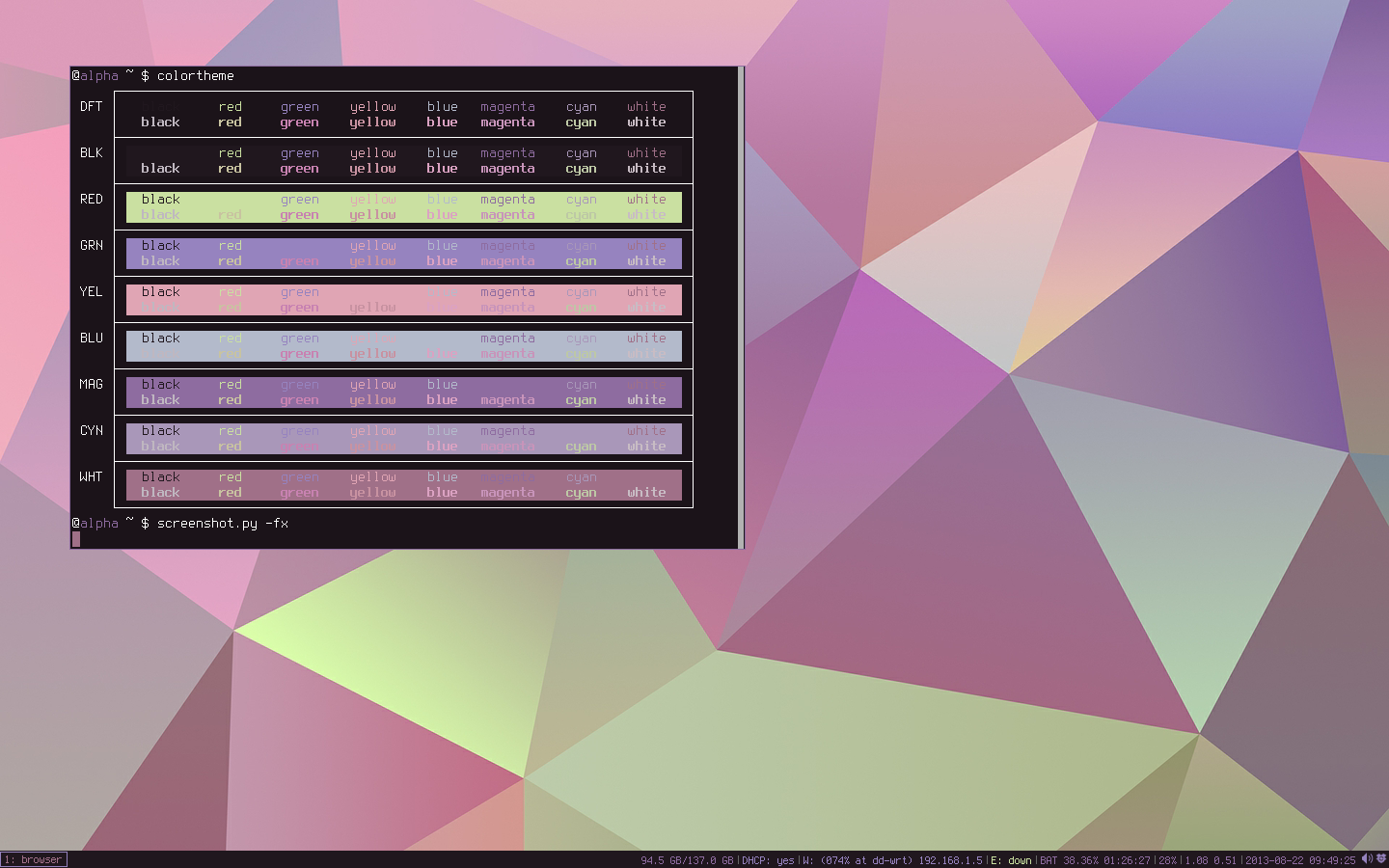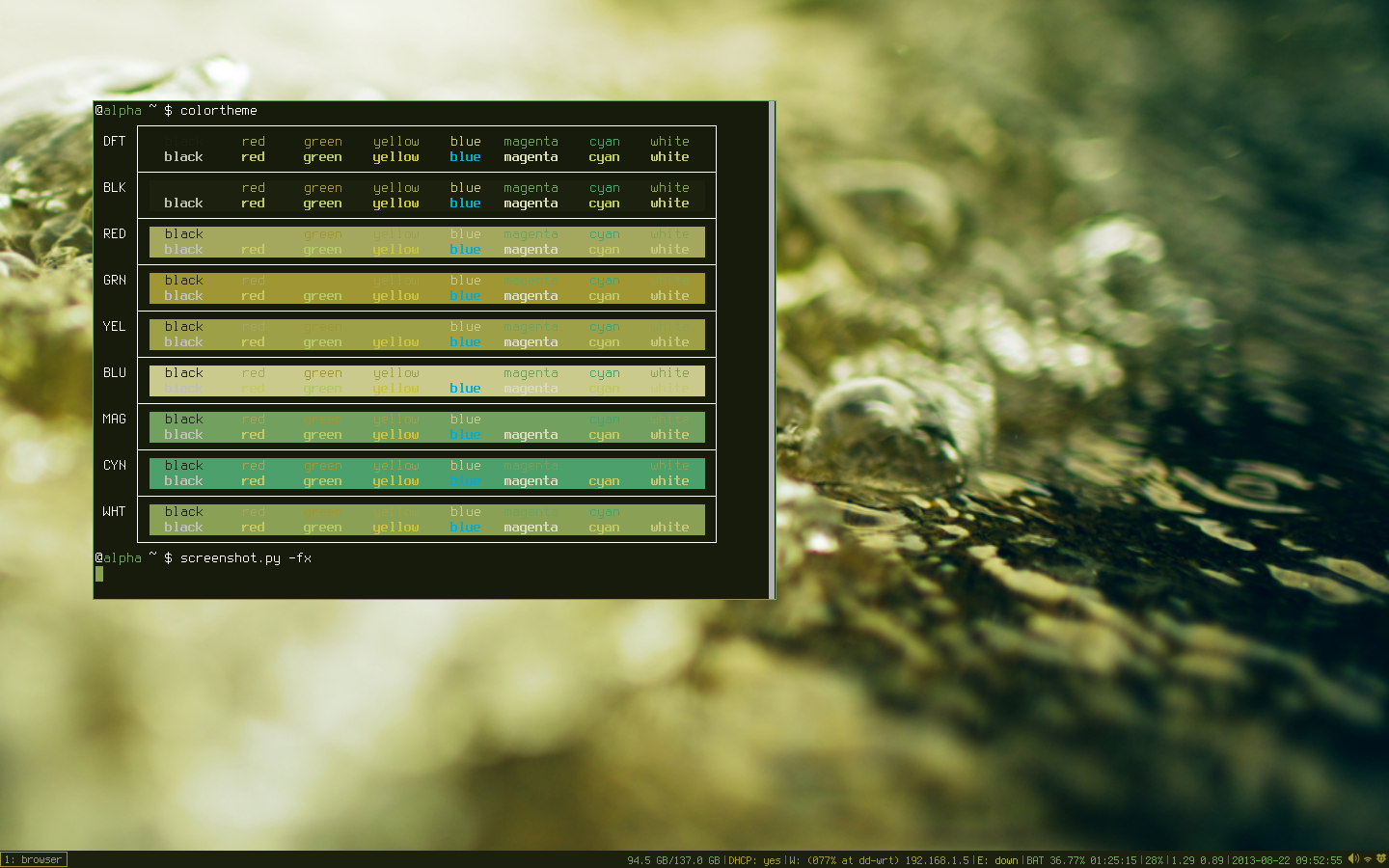Themer is a colorscheme generator and manager for your desktop.
Project description
Themer
======
*Themer is a colorscheme generator and manager for your desktop.*
Installation
------------
### AUR (Arch)
Install [python-themer-git](https://aur.archlinux.org/packages/python-themer-git/) with the AUR manager of your choice:
$ yaourt -S python-themer-git
### PyPi
`themer` is now available in the PyPi repository as well. You can use a tool like `pip` to install it:
$ pip install themer
### Manual Installation
First, check out the git repository:
$ git clone https://github.com/S0lll0s/themer.git
Install with `python setup.py install`
$ cd themer
$ sudo python setup.py install
Configuration
-------------
You can create multiple template dirs for `themer` in `~/.config/themer/templates`.
The default template is `i3`; see [data/default](data/default) for the default configuration.
Usage
-----
### Integrating Themer with your Setup
All the following steps will show you how to use `themer` to generate themes,
but you also need to configure your DE to use the generated theme.
`themer` does not assume anything about the tools you use in your DE, you need to tell your DE about `themer`.
The current theme will always be available in `$XDG_HOME/themer/current` (usually `.config/themer/current`).
To use `themer`, symlink the seperate files from there to their destination.
For example, this is how to set up `i3` with `themer`:
$ mkdir -p .i3
$ ln -s ~/.config/themer/current/i3.conf .i3/config
### Generating Themes
Generate a theme from a wallpaper:
$ themer generate themename wallpaper.png
...or install a colorscheme from `sweyla.com`:
$ themer generate themename 693812
(this will install [http://sweyla.com/themes/seed/693812/](http://sweyla.com/themes/seed/693812/))
you can also use an Xresources-style file:
$ themer generate themename /home/me/.Xresources
[Plugins](#plugins) enable you to generate themes from other sources as well, see below.
### Viewing Installed Themes
You can list all generated themes with `themer list`:
$ themer list
themeone
themetwo
### Viewing Installed Plugins
$ themer plugins
Enabled activators:
themer.activators.wallfix.WallfixActivator
themer.activators.i3.I3Activator
Enabled parsers:
themer.parsers.SweylaColorParser
themer.parsers.KmeansColorParser
themer.parsers.CachedColorParser
themer.ColorParser
### Activating Themes
You can activate an existing theme with `themer activate`:
$ themer activate sometheme
This will symlink all defined templates to `~/.config/themer/current`. You should, in turn, symlink all the global configuration files to there. For example for i3:
$ ln -s ~/.config/themer/current/i3.conf ~/.i3/config
To view the currently activated theme's colors use `themer current`.
If you have modified the templates, activating the theme again will not apply those changes. Instead
use `themer render` to update your configuration:
$ themer render sometheme
You can also re-render all of your themes (for example if you changed a lot in your configuration) by supplying `all` instead of a theme's name:
$ themer render all
### Deleting Themes
Deleting generated themes is possible using `themer delete`:
$ themer delete sometheme
Screenshots
-----------








Plugins
-------
Plugins can be installed anywhere into your PYTHONPATH, but the `plugins` directory under the used template dir is automatically added to `sys.path`, so you may want to place them there (usually this is `~/.config/themer/templates/i3/plugins`).
They are loaded via their python module-an-classname string; e.g. `mymodule.activator.MyActivator`.
Plugins are configured on a template-directory basis, in the `config.yaml` file (default `~/.config/themer/templates/i3/config.yaml`).
There are two kinds of plugins: **Activators** and **Parsers**.
Activators should inherit from `themer.ThemeActivator`, Parsers should inherit from `themer.ColorParser`.
### `ThemeActivator`s
Activators are run once every time a theme is activated. Use them to reload configuration files, set desktop wallpapers etc.
Each Activator should implement the method `activate`.
The constructor is passed the values for `theme_name`, `theme_dir` and `logger`.
All of these and `colors` can be accessed via the instance's properties.
#### Example:
from themer import ThemeActivator
import os
class I3Activator(ThemeActivator):
def activate(self):
os.system('i3-msg -q restart')
### `ColorParser`s
Parsers are used to generate colorschemes from files and strings.
Each ColorParser should implement the method `read`, which should return the color dictionary generated from the input string in `self.data` (or obtained via the constructor's first argument).
A ColorParser can additionally return a path to a wallpaper to be used by setting `self.wallpaper` to anything other than `None`.
Additionally, Parsers need to have a `check` attribute. It is used to determine whether a Parser should be used for a given color source. `check` can either be a function, in which case it is passed the color-source string and expected to return a truthy value if it wants to handle that color source, or a string.
If it is a string it will be used as a regex and matched against the color source string.
The `themer.check_file_regex` helper can be used to build a `check` function that checks filenames against a regex and verifies their existence on the filesystem.
The constructor is passed the values for `data`, `config` and `logger`.
All of these can be accessed via the instance's properties.
The default constructor also sets `self.colors` to a new dictionary and `self.wallpaper` to `None`.
#### Example:
from themer import ColorParser, check_file_regex
class NewColorParser(ColorParser):
check = check_file_regex('\.yaml$')
def read(self):
with open(self.data) as fh: # load colors from a yaml file
self.colors = yaml.load(fh)
return self.colors
Credits
-------
Original script by [Charles Leifer](https://github.com/coleifer)
Maintained and developed further by [Sol Bekic](https://github.com/S0lll0s)
======
*Themer is a colorscheme generator and manager for your desktop.*
Installation
------------
### AUR (Arch)
Install [python-themer-git](https://aur.archlinux.org/packages/python-themer-git/) with the AUR manager of your choice:
$ yaourt -S python-themer-git
### PyPi
`themer` is now available in the PyPi repository as well. You can use a tool like `pip` to install it:
$ pip install themer
### Manual Installation
First, check out the git repository:
$ git clone https://github.com/S0lll0s/themer.git
Install with `python setup.py install`
$ cd themer
$ sudo python setup.py install
Configuration
-------------
You can create multiple template dirs for `themer` in `~/.config/themer/templates`.
The default template is `i3`; see [data/default](data/default) for the default configuration.
Usage
-----
### Integrating Themer with your Setup
All the following steps will show you how to use `themer` to generate themes,
but you also need to configure your DE to use the generated theme.
`themer` does not assume anything about the tools you use in your DE, you need to tell your DE about `themer`.
The current theme will always be available in `$XDG_HOME/themer/current` (usually `.config/themer/current`).
To use `themer`, symlink the seperate files from there to their destination.
For example, this is how to set up `i3` with `themer`:
$ mkdir -p .i3
$ ln -s ~/.config/themer/current/i3.conf .i3/config
### Generating Themes
Generate a theme from a wallpaper:
$ themer generate themename wallpaper.png
...or install a colorscheme from `sweyla.com`:
$ themer generate themename 693812
(this will install [http://sweyla.com/themes/seed/693812/](http://sweyla.com/themes/seed/693812/))
you can also use an Xresources-style file:
$ themer generate themename /home/me/.Xresources
[Plugins](#plugins) enable you to generate themes from other sources as well, see below.
### Viewing Installed Themes
You can list all generated themes with `themer list`:
$ themer list
themeone
themetwo
### Viewing Installed Plugins
$ themer plugins
Enabled activators:
themer.activators.wallfix.WallfixActivator
themer.activators.i3.I3Activator
Enabled parsers:
themer.parsers.SweylaColorParser
themer.parsers.KmeansColorParser
themer.parsers.CachedColorParser
themer.ColorParser
### Activating Themes
You can activate an existing theme with `themer activate`:
$ themer activate sometheme
This will symlink all defined templates to `~/.config/themer/current`. You should, in turn, symlink all the global configuration files to there. For example for i3:
$ ln -s ~/.config/themer/current/i3.conf ~/.i3/config
To view the currently activated theme's colors use `themer current`.
If you have modified the templates, activating the theme again will not apply those changes. Instead
use `themer render` to update your configuration:
$ themer render sometheme
You can also re-render all of your themes (for example if you changed a lot in your configuration) by supplying `all` instead of a theme's name:
$ themer render all
### Deleting Themes
Deleting generated themes is possible using `themer delete`:
$ themer delete sometheme
Screenshots
-----------








Plugins
-------
Plugins can be installed anywhere into your PYTHONPATH, but the `plugins` directory under the used template dir is automatically added to `sys.path`, so you may want to place them there (usually this is `~/.config/themer/templates/i3/plugins`).
They are loaded via their python module-an-classname string; e.g. `mymodule.activator.MyActivator`.
Plugins are configured on a template-directory basis, in the `config.yaml` file (default `~/.config/themer/templates/i3/config.yaml`).
There are two kinds of plugins: **Activators** and **Parsers**.
Activators should inherit from `themer.ThemeActivator`, Parsers should inherit from `themer.ColorParser`.
### `ThemeActivator`s
Activators are run once every time a theme is activated. Use them to reload configuration files, set desktop wallpapers etc.
Each Activator should implement the method `activate`.
The constructor is passed the values for `theme_name`, `theme_dir` and `logger`.
All of these and `colors` can be accessed via the instance's properties.
#### Example:
from themer import ThemeActivator
import os
class I3Activator(ThemeActivator):
def activate(self):
os.system('i3-msg -q restart')
### `ColorParser`s
Parsers are used to generate colorschemes from files and strings.
Each ColorParser should implement the method `read`, which should return the color dictionary generated from the input string in `self.data` (or obtained via the constructor's first argument).
A ColorParser can additionally return a path to a wallpaper to be used by setting `self.wallpaper` to anything other than `None`.
Additionally, Parsers need to have a `check` attribute. It is used to determine whether a Parser should be used for a given color source. `check` can either be a function, in which case it is passed the color-source string and expected to return a truthy value if it wants to handle that color source, or a string.
If it is a string it will be used as a regex and matched against the color source string.
The `themer.check_file_regex` helper can be used to build a `check` function that checks filenames against a regex and verifies their existence on the filesystem.
The constructor is passed the values for `data`, `config` and `logger`.
All of these can be accessed via the instance's properties.
The default constructor also sets `self.colors` to a new dictionary and `self.wallpaper` to `None`.
#### Example:
from themer import ColorParser, check_file_regex
class NewColorParser(ColorParser):
check = check_file_regex('\.yaml$')
def read(self):
with open(self.data) as fh: # load colors from a yaml file
self.colors = yaml.load(fh)
return self.colors
Credits
-------
Original script by [Charles Leifer](https://github.com/coleifer)
Maintained and developed further by [Sol Bekic](https://github.com/S0lll0s)
Project details
Download files
Download the file for your platform. If you're not sure which to choose, learn more about installing packages.
Source Distribution
Themer-1.7.tar.gz
(18.6 kB
view hashes)











